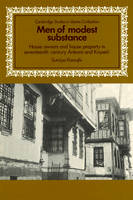
Men of Modest Substance
House Owners and House Property in Seventeenth-Century Ankara and Kayseri
Seiten
2002
Cambridge University Press (Verlag)
978-0-521-52255-7 (ISBN)
Cambridge University Press (Verlag)
978-0-521-52255-7 (ISBN)
This study of two contrasting towns in Anatolia focuses on their domestic environment. Through her use of documents from the kadi registers of Ankara and Kayseri, Dr Faroqui follows changes in patterns of house ownership over approximately a century. The urban society thus revealed differs from the patterns generally associated with the 'Islamic city' model.
This is a study of two contrasting towns in Anatolia in the seventeenth century. As house ownership was widespread, data concerning value, description, location and ownership of dwellings constitute a valid manner of approaching urban society as a whole. Through her use of documents from the kadi registers of Ankara and Kayseri, Dr Faroqui follows changes in patterns of house ownership over approximately a century. The urban society thus revealed differs from the patterns generally associated with the 'Islamic city' model. Townsmen often bought real estate without selecting a quarter inhabited by their co-religionists, which throws light on the Muslim majority's attitude to the Christian minority. However examples of wealthy and poor quarters were not known. The kadi registers also indicate that despite passing through a period of crisis early in the century, both cultures managed a fairly rapid recovery from this.
This is a study of two contrasting towns in Anatolia in the seventeenth century. As house ownership was widespread, data concerning value, description, location and ownership of dwellings constitute a valid manner of approaching urban society as a whole. Through her use of documents from the kadi registers of Ankara and Kayseri, Dr Faroqui follows changes in patterns of house ownership over approximately a century. The urban society thus revealed differs from the patterns generally associated with the 'Islamic city' model. Townsmen often bought real estate without selecting a quarter inhabited by their co-religionists, which throws light on the Muslim majority's attitude to the Christian minority. However examples of wealthy and poor quarters were not known. The kadi registers also indicate that despite passing through a period of crisis early in the century, both cultures managed a fairly rapid recovery from this.
Tables; Graphs; Illustrations; Figures; Abbreviations; Preface; Introduction; 1. Setting the scene: two cities of central Anatolia; 2. The physical shape of urban houses; 3. The cost of buying a house; 4. Urban property-owners; 5. The difficulties of an urban property-owner; Conclusion; Glossary; Notes; Bibliography; Index.
| Erscheint lt. Verlag | 8.8.2002 |
|---|---|
| Reihe/Serie | Cambridge Studies in Islamic Civilization |
| Zusatzinfo | Worked examples or Exercises |
| Verlagsort | Cambridge |
| Sprache | englisch |
| Maße | 154 x 230 mm |
| Gewicht | 478 g |
| Themenwelt | Geisteswissenschaften ► Geschichte ► Allgemeine Geschichte |
| Geschichte ► Teilgebiete der Geschichte ► Kulturgeschichte | |
| Wirtschaft ► Betriebswirtschaft / Management ► Rechnungswesen / Bilanzen | |
| Betriebswirtschaft / Management ► Spezielle Betriebswirtschaftslehre ► Immobilienwirtschaft | |
| ISBN-10 | 0-521-52255-2 / 0521522552 |
| ISBN-13 | 978-0-521-52255-7 / 9780521522557 |
| Zustand | Neuware |
| Haben Sie eine Frage zum Produkt? |
Mehr entdecken
aus dem Bereich
aus dem Bereich
der stille Abschied vom bäuerlichen Leben in Deutschland
Buch | Hardcover (2023)
C.H.Beck (Verlag)
CHF 32,15
vom Mittelalter bis zur Gegenwart
Buch | Softcover (2024)
C.H.Beck (Verlag)
CHF 16,80


